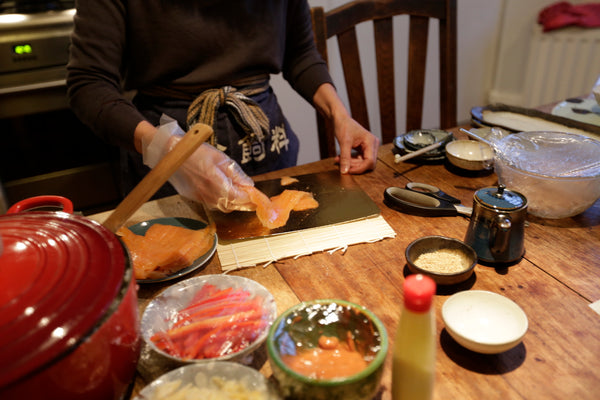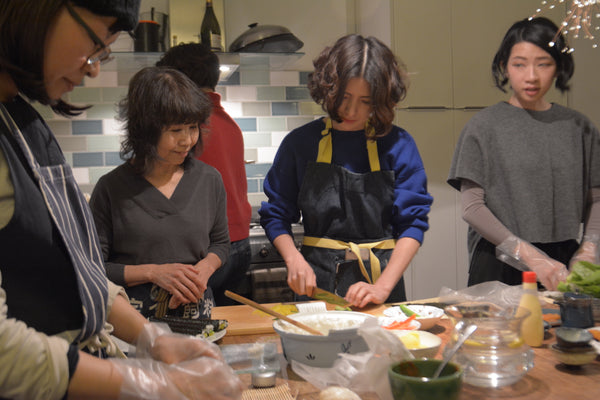February 27, 2018

(Pictured above: some of our handmade Japanese ceramic dishes, which you can find in our Ceramics Collection.)
Japanese ceramics are praised for their simplicity and the attention to detail that goes into their making. A ceramic artisan will traditionally devote his (or her) life to mastering one specific technique, as depth of skill is more generally cherished than breadth in Japan. Besides leading to the creation of valued masterpieces, this focus can also give the artisan 'ikigai', loosely translated as ‘a reason to get up in the morning’, or simply, ‘having a purpose in one’s life’.
The effects of ikigai can be profound, as the two Spanish authors, Hector Garcia and Francesc Miralles, recently discovered. They wrote a beautiful book about it, Ikigai - The Japanese Secret to a Long and Happy Life (reviewed in the Guardian), in which they mention Steve Jobs’s fascination with the work of the ceramic artisan Yukio Shakunaga, and indeed, the man himself. This ‘takumi’ from Toyama immerses himself into his technique of Etchu Seto-Yaki to the point of going to the mountain to personally retrieve the porcelain he is using in his work. (It clearly isn't about speed.)
Yukio Shakunaga's devotion to his work made me think of David Gelb's documentary 'Jiro Dreams of Sushi' about Jiro Ono, the famous sushi chef, in whose restaurant in Tokyo people reserve a seat months in advance (there are 10 seats along the counter, a meal costs upwards of £200 and lasts about 15 minutes). Only sushi, no starters, no desserts, and a stern-looking Jiro watching you as you eat. The fascinating, and very beautiful film, showing the master at work, aged 85, demonstrates ikigai in action. Here’s the trailer to wet your appetite; you can watch the whole film on Youtube, Netflix or iTunes.
Even though the above examples might suggest this, ikigai is not reserved for elitist endeavours. You can also find it in simple pursuits, like making home-made sushi with family, friends and colleagues.
We discovered this for ourselves on a recent Sunday afternoon, when Kumiko's mum, Keiko, who was visiting from Japan, taught us how to make home-made sushi. Keiko has made sushi professionally, until she retired a few years ago. Now she works in a different job, keeping up her ikigai.
(Pictured above: Keiko in Guy's kitchen, cutting a roll of sushi)
Making home-made sushi was much easier than we thought and very delicious. Keiko did not use raw tuna or salmon - as I had wondered in advance. She shook her head and laughed, as she confirmed that it would have been too difficult for her to find fresh fish suitable for raw fish sushi. 'You can make sushi with everything', she said, pointing to some already prepared fish fingers, smoked salmon, and canned tuna, that were laid out on Guy's kitchen table. There were also a bowl of thinly sliced egg omelette, cucumber batons, salad leaves, carrots, red peppers, and a sauce made from ketchup and Japanese Kewpie Mayonnaise - which you can buy in many Asian supermarkets in London. (It's the cream bottle with the red lid in the image below.)

The vinegared sushi rice is in the red cast iron pot, and at the moment the picture was taken, Keiko was putting smoked salmon on a small plate for easier handling.
To start with, Keiko put a sheet of dried nori on a sushi rolling mat and measured 275g of prepared sushi rice, which she shaped into a lose ball with her hands. Then, beginning at the top left corner, she distributed the rice evenly across the nori sheet. As you can see, she was wearing plastic gloves. They are lightly covered in sunflower oil, to avoid that the very sticky sushi rice sticks to the hands.
Keiko sprinkled sesame seeds on top of the rice, and after that, added further ingredients on top.
She also made rolls with sesame seeds and rice on the outside ...
... adding even layers of filling across the middle ...
I was surprised to see how high the heap of ingredients became in the end ...
Once you've put all the ingredients you fancy on the rice or nori, you pick up the bottom end of the rice-nori-mat, swiftly move it over the filling and tighten the roll a bit.
Pause for a brief moment, then carefully move the mat back a little, so you can roll the nori over the rice on the other side of the filling, all the way up. It's a bit fiddly the first time, but once you’ve rolled the whole thing up, you press it very gently, so as to encourage the rice and the nori to stick together where they touch.
You can then remove the roll from the mat and put it on a plate or board for about 10 minutes, to settle before you cut and serve it.
After watching Keiko, some of us had a go: first, Kumiko and I ...
... then, Lei's son Lucio ...
... and Kumiko's husband Andrew ...
... Miae and Yun, too ...

... and of course, Lei.
And while some people were having fun playing a dance game on TV ...
... Lei and Miae made Chinese and Korean dumplings to go along the sushi:
As the Korean dumplings were frying in the pan and the Chinese dumplings were steaming in the pot, Keiko began to cut the sushi rolls:
... and arranged them beautifully on Japanese serving dishes ...
Finally, the table was set ...
... and we all tugged in. No picture to proof it, but it was delicious. What a lovely afternoon with friends, colleagues and family, full of ikigai :-)
Thank you, Keikosan!
February 26, 2025
We invite you to explore our latest collection of homeware, gifts, and seasonal pieces in our Spring Round-Up Blog Post. Whether you're looking for timeless Japanese ceramics, striking prints, or thoughtful gifts, there's something special waiting for you at Rouge this spring.
December 23, 2024
2024 has been an incredible year for Rouge, but it hasn’t been without its challenges. Together, we navigated a tough year of reduced foot traffic and shoppers on Stoke Newington High Street. But thanks to you—our cherished customers, friends, and families—we’re heading into our 20th year in business stronger than ever! Read our year in review here.
November 07, 2024
